Open Journal of Statistics
Vol.2 No.1(2012), Article ID:16877,9 pages DOI:10.4236/ojs.2012.21011
Wrapped Skew Laplace Distribution on Integers: A New Probability Model for Circular Data
1University of Calicut, Kerala, India
2MES Asmabi College, Kerala, India
Email: {jkumar19, sophyjacob}@rediffmail.com
Received September 19, 2011; revised October 21, 2011; accepted October 31, 2011
Keywords: Circular Distributions; Trigonometric Moments; Wrapped Laplace Distribution
ABSTRACT
In this paper we propose a new family of circular distributions, obtained by wrapping discrete skew Laplace distribution on Z = 0, ±1, ±2, around a unit circle. In contrast with many wrapped distributions, here closed form expressions exist for the probability density function, the distribution function and the characteristic function. The properties of this new family of distribution are studied.
1. Introduction
Circular data arise in various ways. Two of the most common correspond to circular measuring instruments, the compass and the clock. Data measured by compass usually include wind directions, the direction and orientations of birds and animals, ocean current directions, and orientation of geological phenomena like rock cores and fractures. Data measured by clock includes times of arrival of patients at a hospital emergency room, incidences of a disease throughout the year, where the calendar is regarded as a one-year clock. Circular or directional data also arise in many scientific fields, such as Biology, Geology, Meteorology, Physics, Psychology, Medicine and Astronomy [1].
Study on directional data can be dated back to the 18th century. In 1734 Daniel Bernoulli proposed to use the resultant length of normal vectors to test for uniformity of unit vectors on the sphere [2]. In 1918 von Mises introduced a distribution on the circle by using characterization analogous to the Gauss characterization of the normal distribution on a line [2]. Later, interest was renewed in spherical and circular data by [3-5].
Circular distributions play an important role in modeling directional data which arise in various fields. In recent years, several new unimodal circular distributions capable of modeling symmetry as well as asymmetry have been proposed. These include, the wrapped versions of skew normal [6], exponential [7] and Laplace [8].
Wrapped distributions provide a rich and useful class of models for circular data.
The special cases of the wrapped normal, wrapped Poisson, wrapped Cauchy are discussed in [9]. We give a brief description of circular distribution in Section 2. In Section 3 we introduce and study Wrapped Discrete Skew Laplace Distribution. Section 4 deals with the estimation of the parameters using the method of moments.
2. Circular Distributions
A circular distribution is a probability distribution whose total probability is concentrated on the circumference of a circle of unit radius. Since each point on the circumference represents a direction, it is a way of assigning probabilities to different directions or defining a directional distribution. The range of a circular random variable Θ measured in radians, may be taken to be  or
or .
.
Circular distributions are of two types: they may be discrete - assigning probability masses only to a countable number of directions, or may be absolutely continuous. In the latter case, the probability density function  exists and has the following basic properties.
exists and has the following basic properties.
1) 
2) 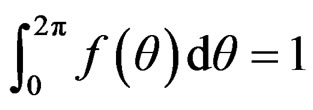
3) , for any integer k. That is
, for any integer k. That is  is periodic with period
is periodic with period .
.
Wrapped Distributions
One of the common methods to analyze circular data is known as wrapping approach [10]. In this approach, given a known distribution on the real line, we wrap it around the circumference of a circle with unit radius. Technically this means that if X is a random variable on the real line with distribution function , the random variable
, the random variable of the wrapped distribution is defined by
of the wrapped distribution is defined by
 (1)
(1)
and the distribution function of  is given by
is given by
 (2)
(2)
By this approach, we are accumulating probability over all the overlapping points  So if
So if  represents a circular density and
represents a circular density and  the density of the real valued random variable, we have
the density of the real valued random variable, we have
 (3)
(3)
By this technique, both discrete and continuous wrapped distributions may be constructed. In particular, if X has a distribution concentrated on the points
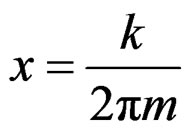 ,
,  and m is an integer, the probability function of
and m is an integer, the probability function of  is given by
is given by
 (4)
(4)
where “p” is the probability function of the random variable X.
3. Wrapped Discrete Skew Laplace Distribution
3.1. Discrete Skew Laplace Distribution
Discrete Laplace distribution was introduced by [11] following [12], who defined a discrete analogue of the normal distribution. The probability mass function of a general Discrete Normal random variable Y can be written in the form
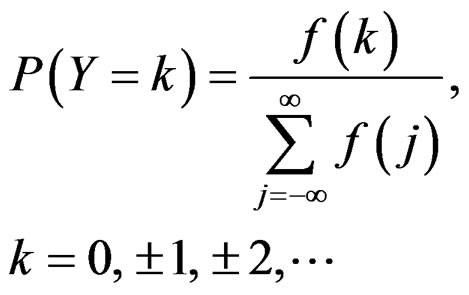 . (5)
. (5)
where “f” is the probability density function of a normal distribution with mean µ and variance  [13].
[13].
Using Equation (5), for any continuous random variable X on R, we can define a discrete random variable Y that has integer support on Z. When the skew Laplace density
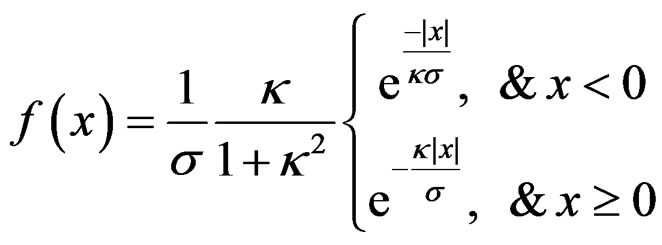 (6)
(6)
where,  , are inserted into Equation (5), the probability mass function of the resulting discrete distribution takes an explicit form in terms of the parameters p* =
, are inserted into Equation (5), the probability mass function of the resulting discrete distribution takes an explicit form in terms of the parameters p* =
 and
and .
.
Definition 3.1 A random variable Y has a discrete skew Laplace distribution with parameters 
and  denoted by DSL
denoted by DSL , if
, if
 (7)
(7)
The characteristic function of Y is given by
 (8)
(8)
In this paper, we study the probability distribution obtained by wrapping discrete skew Laplace distribution on  around a unit circle.
around a unit circle.
As we know, reduction modulo 2π wraps the line onto the circle, reduction modulo 2πm (if m is a positive integer) wraps the integers onto the group of  root of 1, regarded as a subgroup of the circle. That is, if X is a random variable on the integers, then Θ, defined by
root of 1, regarded as a subgroup of the circle. That is, if X is a random variable on the integers, then Θ, defined by

is a random variable on the lattice ,
, on the circle. The probability function of Θ is given by Equation (4).
on the circle. The probability function of Θ is given by Equation (4).
In particular, if X has a discrete skew Laplace distribution with parameters  and
and , then the probability distribution of the wrapped random variable
, then the probability distribution of the wrapped random variable 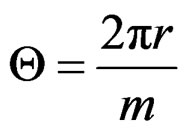 is given by
is given by
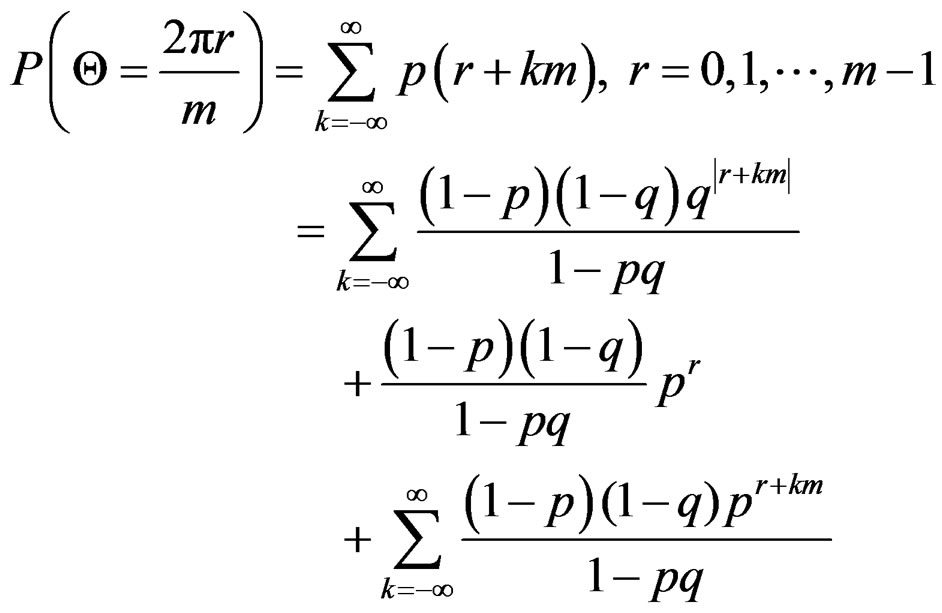
where  and
and
 (9)
(9)
for  and
and
Again, we have
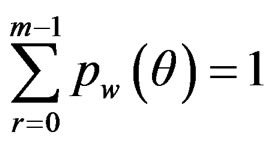
Hence  represents a probability distribution.
represents a probability distribution.
Definition 3.2 An angular random variable “Θ” is said to follow wrapped skew Laplace distribution on integers with parameters p, q and m if its probability mass function is given by
 (10)
(10)
 and we denote it by WDSL
and we denote it by WDSL .
.
Following are the graphs of wrapped discrete skew Laplace distribution for various values of κ, σ and m. In Figure 1, the graph of the pdf of wrapped discrete skew Laplace distribution for κ = 0.25, σ = 1 and for m = 5, 10, 20, 30, 40, 50 and 100 are given.
In Figure 2, the graph of the pdf of wrapped discrete skew Laplace distribution for κ = 0.5, σ = 1 and for m = 5, 10, 20, 30, 40, 50 and 100 are given. The graph of the pdf of wrapped discrete skew Laplace distribution for κ = 0.25, σ = 1 and for m = 5, 10, 20, 30, 40, 50 and 100 are given in Figure 3.
3.2. Special Cases
When either “p” or “q” converges to zero, we obtain the following two special cases:  with
with  is a wrapped geometric distribution with probability mass function
is a wrapped geometric distribution with probability mass function
 (11)
(11)
while  with
with  is a wrapped geometric distribution with probability mass function
is a wrapped geometric distribution with probability mass function
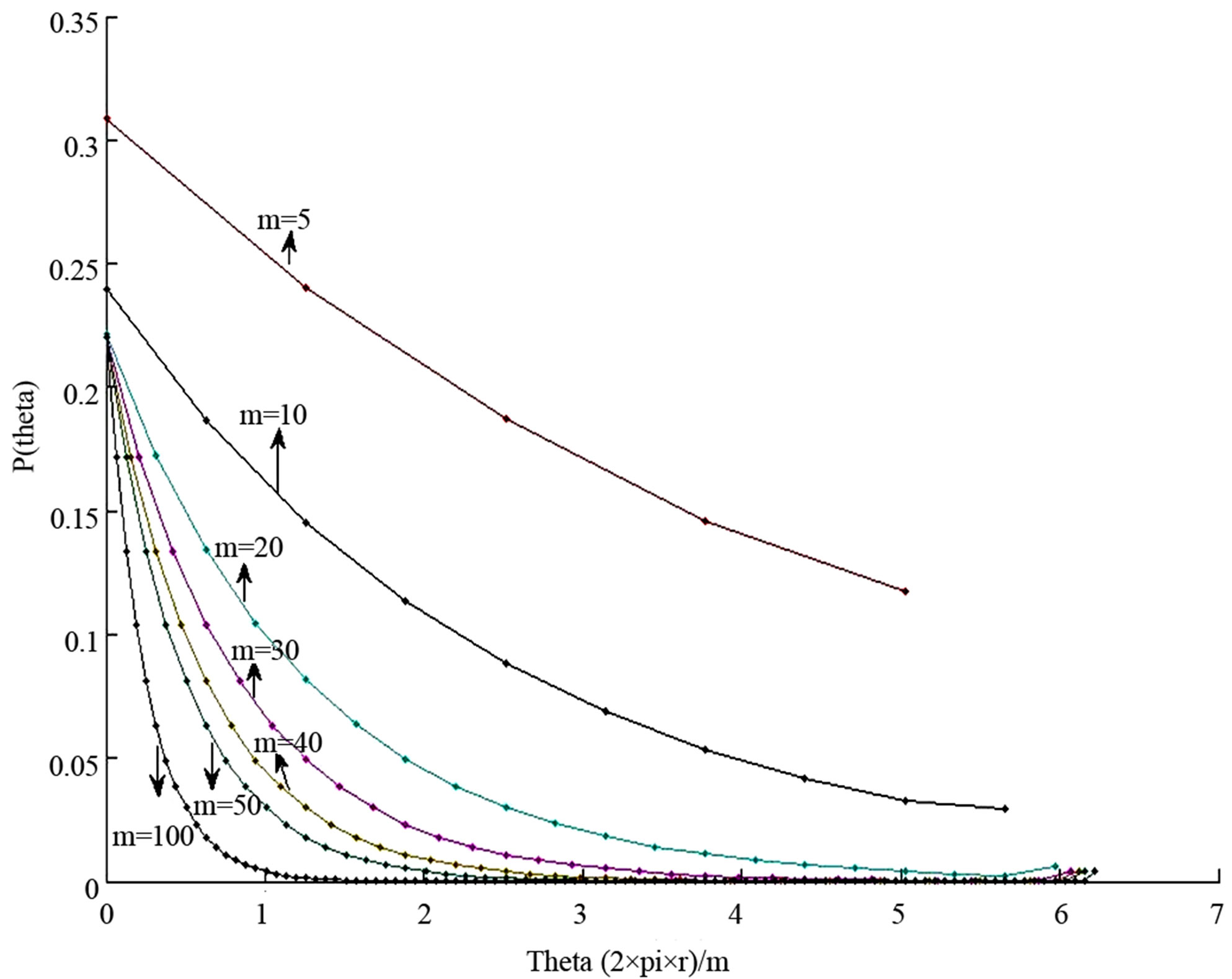
Figure 1. Wrapped discrete skewed Laplace distribution for ,
,  and for different values of “m”.
and for different values of “m”.
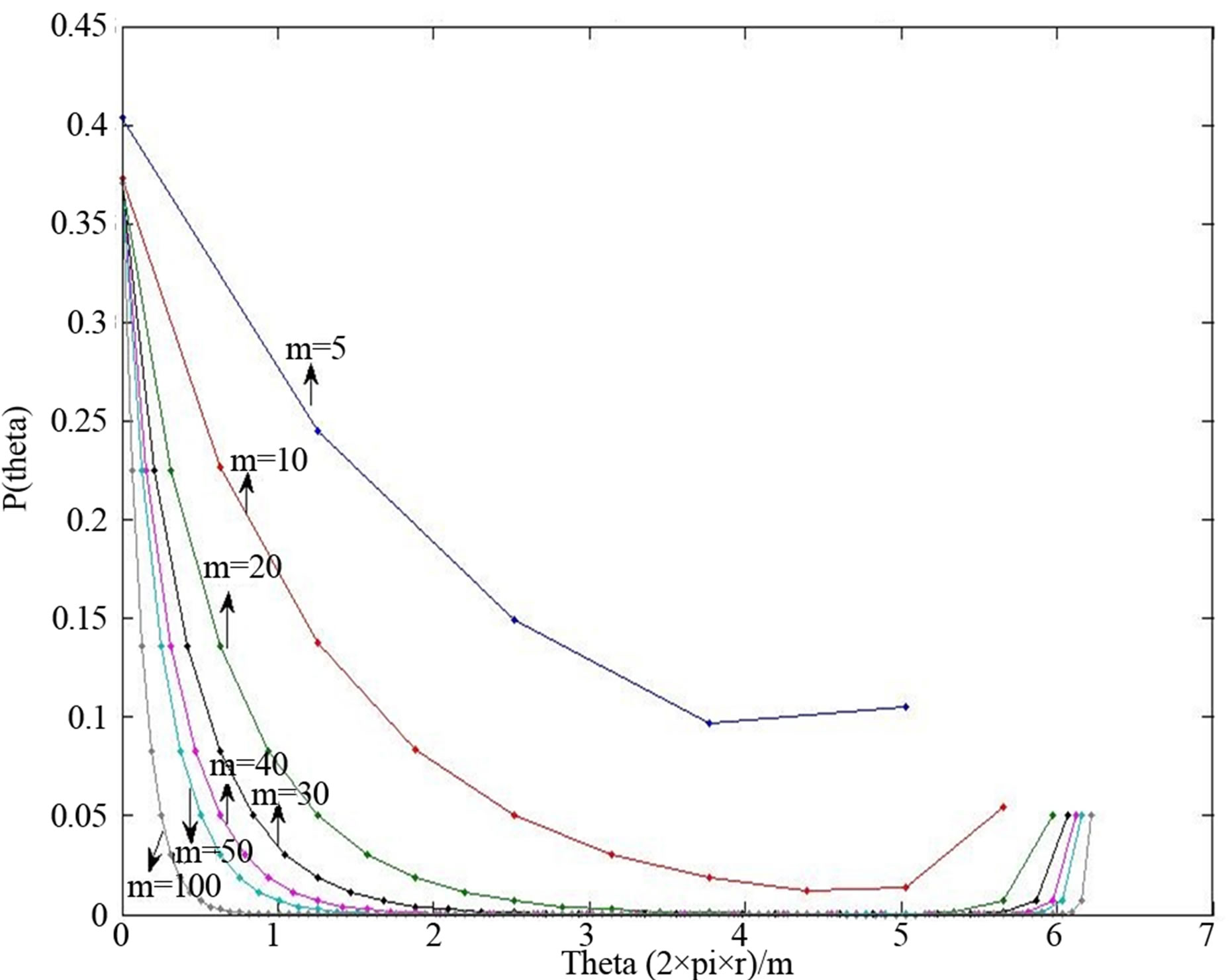
Figure 2. Wrapped discrete skewed Laplace distribution for ,
,  and for different values of “m”.
and for different values of “m”.
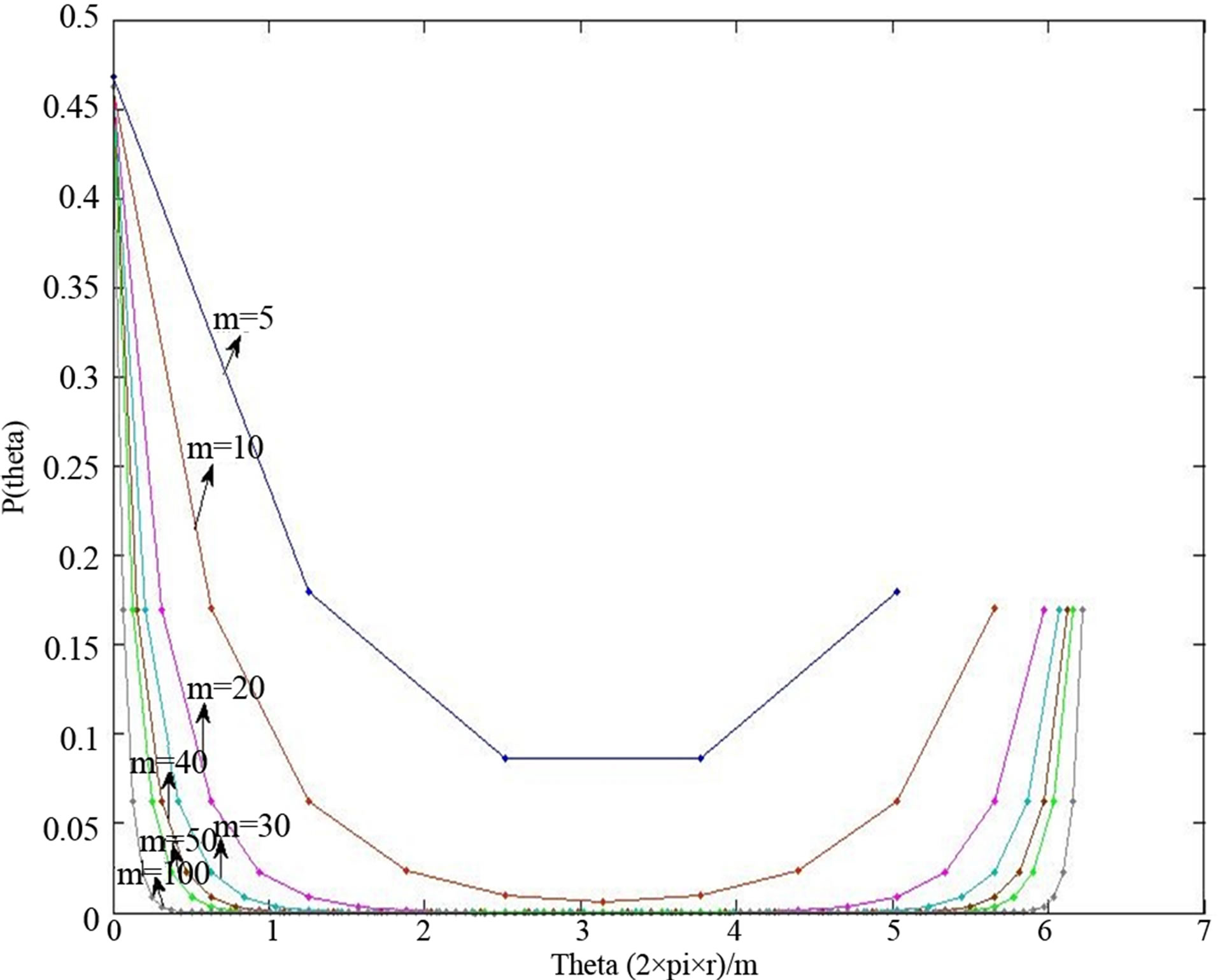
Figure 3. Wrapped discrete skewed Laplace distribution for ,
,  and for different values of “m”.
and for different values of “m”.
 . (12)
. (12)
when p = q, we have
 (13)
(13)
which is the probability mass function of wrapped discrete Laplace distribution.
3.3. Distribution Function of WDSL
The distribution function,  is given by
is given by
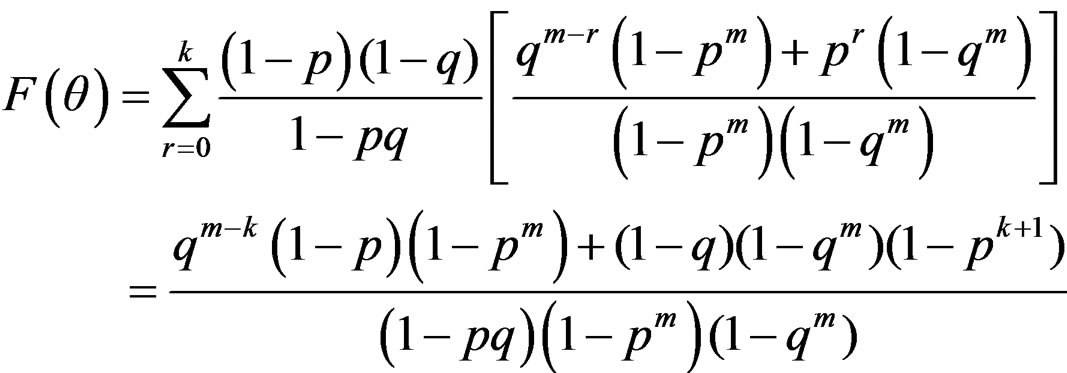 (14)
(14)

3.4. Probability Generating Function and Characteristic Function of WDSL
The probability generating function of WDSL is given by
is given by
 (15)
(15)
Also, we have .
.
when  we have
we have

where 
If  is the characteristic function of a linear random variable X, then the characteristic function of the wrapped random variable,
is the characteristic function of a linear random variable X, then the characteristic function of the wrapped random variable,  is
is 

 [2]. Thus for the wrapped discrete skew Laplace distribution, we have
[2]. Thus for the wrapped discrete skew Laplace distribution, we have
 (16)
(16)
On simplification it reduces to
 ,
,  (17)
(17)
Again, we have

where

(18)
and

(19)
Proposition 3.1 If  then
then 
where  and
and  are two independently distributed wrapped geometric random variables with probability mass functions
are two independently distributed wrapped geometric random variables with probability mass functions
 ,
,
Proof.
We have,


and

Therefore,

3.5. Infinite Divisibility
We know that the geometric distribution with probability mass function,  is infinitely divisible, so wrapped geometric distribution is infinitely divisible. Hence
is infinitely divisible, so wrapped geometric distribution is infinitely divisible. Hence  is infinitely divisible. By the well known factorisation properties of geometric law [14],
is infinitely divisible. By the well known factorisation properties of geometric law [14],  admits a representation involving wrapped negative binomial distribution,
admits a representation involving wrapped negative binomial distribution,  where
where 
 .
.
Consider
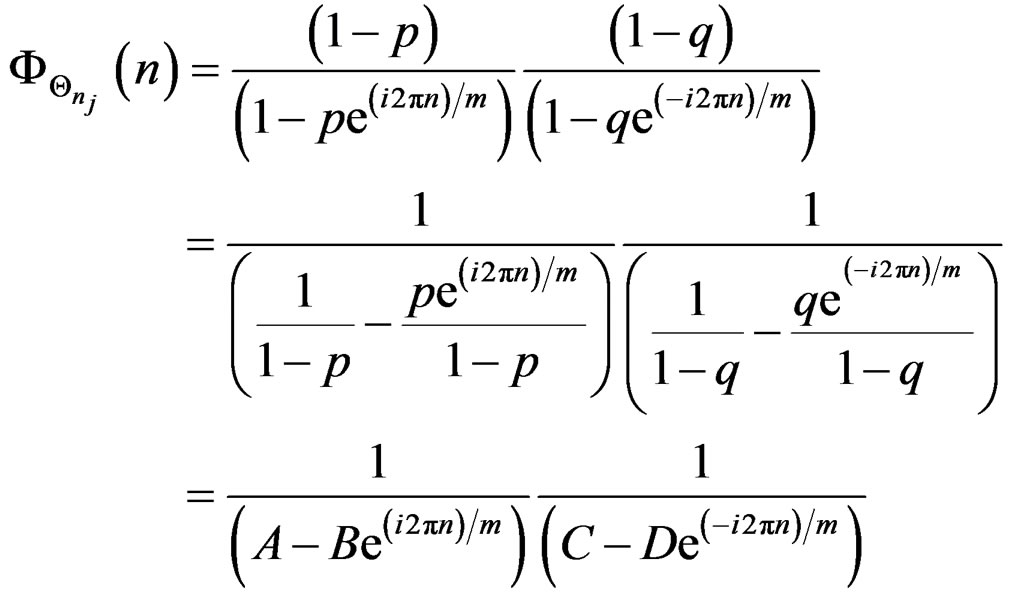
where A, B, C, D > 0, A – B = C – D = 1 and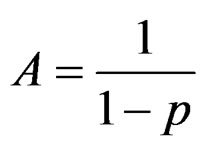 ,
, 
Therefore,

3.6. Stability with Respect to Geometric Summation
Proposition 3.2. Let  be identically and independently distributed
be identically and independently distributed  angular random variables, and let
angular random variables, and let  be a geometric random variable with probability mass function
be a geometric random variable with probability mass function
 independent of
independent of . Then the angular random variable
. Then the angular random variable 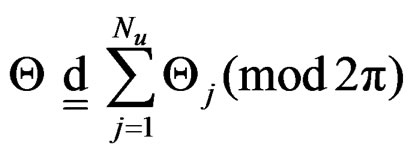 has the WDSL
has the WDSL
 distribution with
distribution with

Proof.
Let  be identically and independently distributed angular random variables following WDSL
be identically and independently distributed angular random variables following WDSL and
and  is a geometric random variable with mean
is a geometric random variable with mean . Conditioning on the distribution of
. Conditioning on the distribution of  we can write the characteristic function of the right hand side of the above equation as (Equation (20))
we can write the characteristic function of the right hand side of the above equation as (Equation (20))
 (20)
(20)
Now we show that the above function coincides with the characteristic function of  distribution with s and r as given above. Setting Equation (20) equal to
distribution with s and r as given above. Setting Equation (20) equal to , which is the characteristic function of
, which is the characteristic function of  distribution, produces the equation
distribution, produces the equation
 (21)
(21)

(22)
That is,
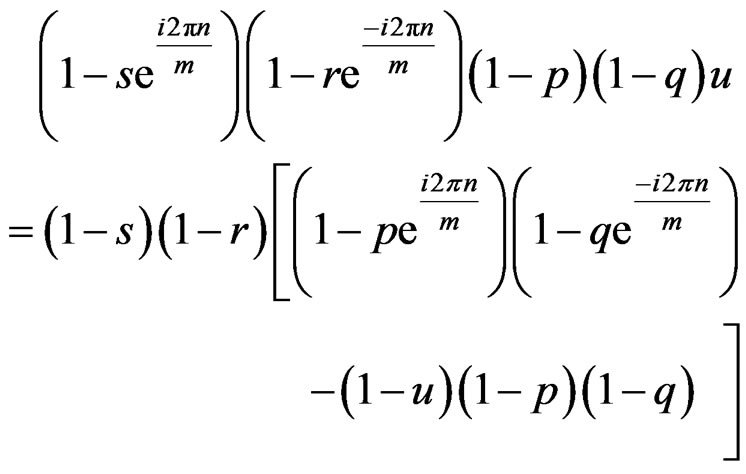
which should hold for each p, q. This will happen when the following two equations hold simultaneously.
 (23)
(23)
 (24)
(24)
Dividing Equation (23) by Equation (24), we get
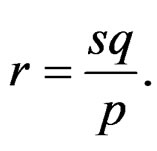 Substituting the value of r in Equation (23) we get
Substituting the value of r in Equation (23) we get
 (25)
(25)
On simplification, Equation (25) reduces to
 (26)
(26)
That is, .
.
Since , and
, and  .
.
Therefore,  admits a unique solution in the interval
admits a unique solution in the interval  and is given by
and is given by
 (27)
(27)
Remark 3.1. Wrapped discrete skew Laplace distribution is infinitely divisible since a circular random variable obtained by wrapping an infinitely divisible random variable is infinitely divisible by [1,11] .
3.7. Trigonometric Moments
The  trigonometric moment of the WDSL
trigonometric moment of the WDSL 
is given by

The above expression can also be expressed in the form

where  is the
is the  th mean resultant length and
th mean resultant length and  is the
is the  th mean direction, for
th mean direction, for 
 (28)
(28)
and
 (29)
(29)
The length of the mean resultant vector,

and the mean direction, 

The circular variance,

The circular standard deviation,

The measure of skewness,
 where
where 
The measure of kurtosis,
 where
where 
4. Estimation
Method of Moments
Let  be a random sample of size n taken from the WDSL
be a random sample of size n taken from the WDSL  distribution with parameters p, q, and m. Then the
distribution with parameters p, q, and m. Then the  sample trigonometric moment about the zero direction,
sample trigonometric moment about the zero direction,
 (30)
(30)
where
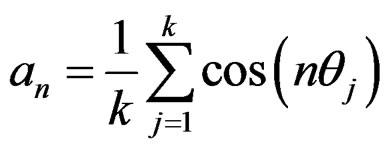 (31)
(31)
and
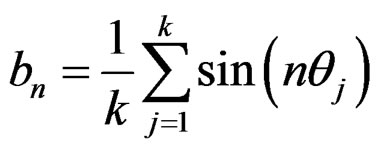 (32)
(32)
Corresponding population moment is  Equating the sample moments to the corresponding population moments, we get
Equating the sample moments to the corresponding population moments, we get  and
and  for
for . Thus, we have
. Thus, we have
 (33)
(33)
and

(34)
Using Equations (33)-(34) and for a fixed value of “m” we can find estimates for “p” and “q”.
We have,
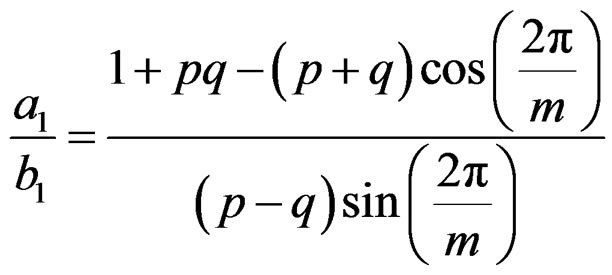
That is

which gives
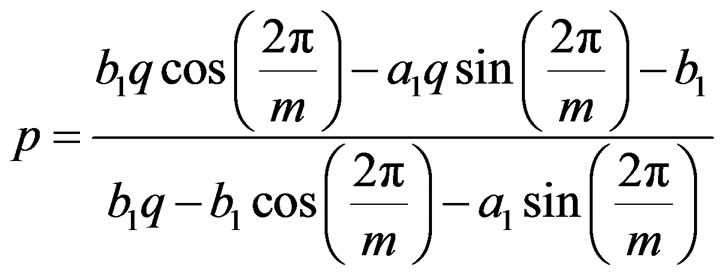 (35)
(35)
Substituting the value of “p” in terms of “q” in Equation (33) or in Equation (34) we will get an equation in “q” and solving that we can find the estimate of “q” and thus “p”.
REFERENCES
- K. V. Mardia and P. E. Jupp, “Directional Statistics,” 2nd Edition, Wiley, New York, 2001.
- K. V. Mardia, “Statistics of Directional Data,” Academic Press, London, 1972.
- R. A. Fisher, “Dispersion on a Sphere,” Proceedings of the Royal Society of London A, Vol. 217, No. 1130, 1953, pp. 295-305. doi:10.1098/rspa.1953.0064
- J. A. Greenwood and D. Durand, “The Distribution of Length and Components of the Sum of n Random Unit Vectors,” Annals of Mathematical Statistics, Vol. 26, No. 2, 1955, pp. 233-246. doi:10.1214/aoms/1177728540
- G. S. Watson and E. J. William, “On the Construction of Significance Tests on the Circle and the Sphere,” Biometrika, Vol. 43, 1956, pp. 344-352.
- A. Pewsey, “A Wrapped Skew—Normal Distribution on the Circle,” Communications in Statistics: Theory and Methods, Vol. 29, No. 11, 2000, pp. 2459-2472. doi:10.1080/03610920008832616
- S. R. Jammalamadaka and T. J. Kozubowski, “A Wrapped Exponential Circular Model,” Proceedings of the Andhra Pradesh Academy of Sciences, Vol. 5, 2001, pp. 43-56.
- S. R. Jammalamadaka and T. J. Kozubowski, “A New Family of Circular Models: The Wrapped Laplace Distributions,” Advances and Applications in Statistics, Vol. 3, No. 1, 2003, pp. 77-103.
- S. R. Jammalamadaka and A. Sengupta, “Topics in Circular Statistics,” World Scientific, Singapore, 2001. doi:10.1142/9789812779267
- P. E. Jupp and K. V. Mardia, “A Unified View of the Theory of Directional Statistics, 1975-1988,” International Statistical Review, Vol. 57, No. 3, 1989, pp. 261- 294. doi:10.2307/1403799
- S. Inusah and T. J. Kozubowski, “A Discrete Analogue of the Laplace Distribution,” Journal of Statistical Planning and Inference, Vol. 136, No. 3, 2006, pp. 1090-1102. doi:10.1016/j.jspi.2004.08.014
- A. W. Kemp, “Characterization of a Discrete Normal Distribution,” Journal of Statistical Planning and Inference, Vol. 63, No. 2, 1997, pp. 223-229. doi:10.1016/S0378-3758(97)00020-7
- P. J. Szablowski, “Discrete Normal Distribution and Its Relationship with Jacobi Theta Functions,” Statistics and Probability Letters, Vol. 52, No. 3, 2001, pp. 289-299. doi:10.1016/S0167-7152(00)00223-6
- W. Feller, “An Introduction to Probability Theory and Its Applications,” John Wiley & Sons, New York, 1957.

